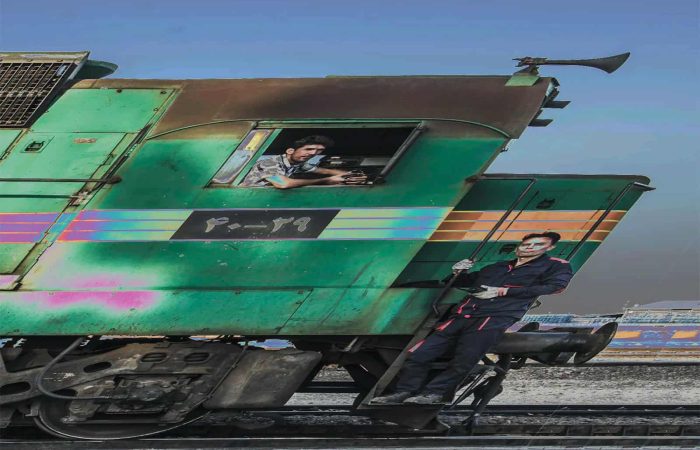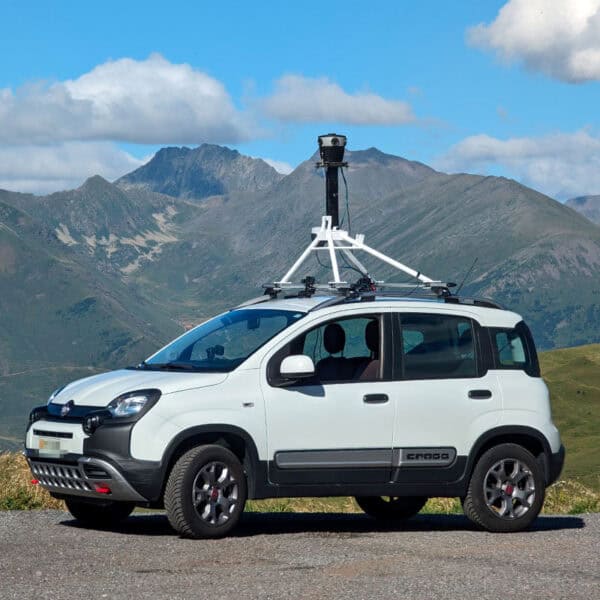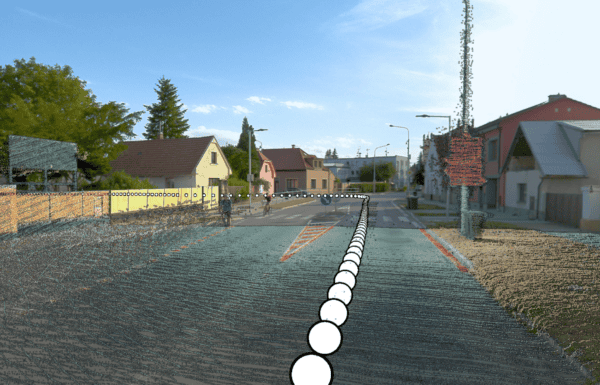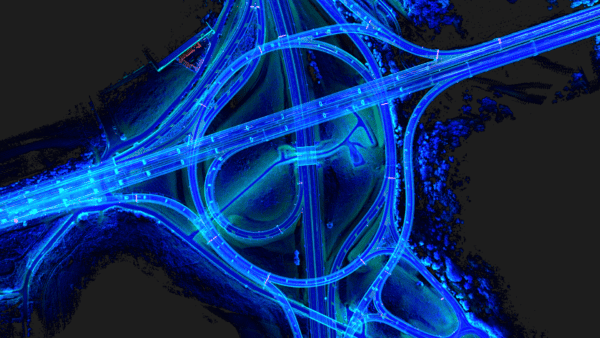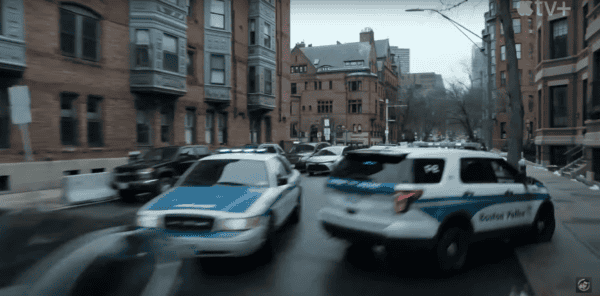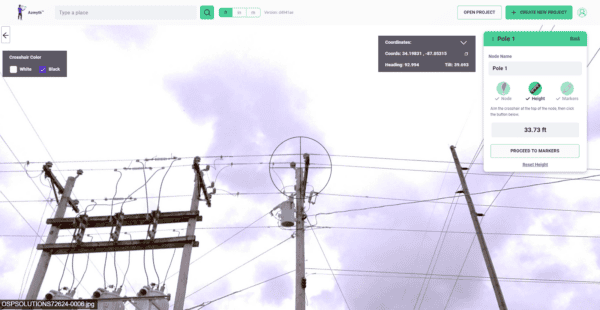The effects of rolling shutter vs global shutter cameras
Let’s take a dive into how rolling shutters vs global shutters can affect the final output of your camera. Stay tuned for some awesome effects of the rolling shutter.
When asked to define a camera and what it can produce, most would say it is a device that captures a moment in time. But how short of a moment can your camera capture? A second? A millisecond? A nanosecond?
Contrary to what most people believe, your camera and most cameras out there cannot capture ONE SINGLE moment in time. In fact, your camera probably actually captures multiple moments in time and splices them all together to give you one solid image. Most of the time, you’re none the wiser. But occasionally, you might notice that something isn’t quite right about your picture.
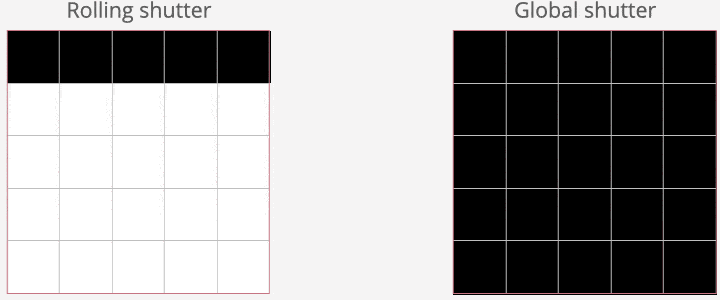
(For some of the more interesting ‘mishaps’ see below.)
What is a rolling shutter?
Rolling shutter is the most common type of shutter found in mobile phones, digital cameras and most video cameras. These cameras contain active-pixel sensors (CMOS), which typically employ rolling shutters in order to capture images.
As previously mentioned, the sensor is not exposed entirely at the same moment in time but rather has a ‘rolling’ quality to the exposure. It is as if a slit is moving either horizontally or vertically across the whole entire image. This occurs at a rate of the maximum frame rate of the particular sensor. For example, if the sensor operates at 30hz or 30fps, a rolling shutter occurs over 1/30 of a second. If the sensor operates at only 10fps, then rolling shutter occurs over about 1/10th of a second (0.1 seconds). In either case, that means tens of images are captured at slightly different moments in time.
While the process is still quite quick, and in most cases, the object of the sensors is not moving quickly enough to have any effect, occasionally, this image-capturing process can significantly affect the outcome of the photography.
What is the rolling shutter effect?
SMIL animation of the rolling shutter effect on a rotating propeller and a moving car. Source: Wikimedia.
The rolling shutter effect creates distortions in the images taken. Since the sensor is exposed in a rolling fashion, it actually captures the images and the light at ever so slightly different positions or brightness. So, for images that are moving quite fast or for scenes with high contrast in light, the final product may seem flawed. The most common effects are listed here. And see below for some mind-blowing images and videos.
Wobble
The wobble effect, also known as the ‘jello effect’ is caused when an unsteady hand holds the camera or when taking a picture from a fast moving car. The rolling shutter will produce a wobbly or fuzzy image. This is why your attempt to take in the beautiful scene out your train window is nearly impossible.
Skew
Similarly, if the subject of the camera or the camera itself is moving from left to right or vice versa, it can cause the image to bend diagonally in one direction. Imagine trying to take a photo of Usain Bolt, the fastest man alive, as he runs by you from right to left. You’ll come away with an image in which you capture his head on the right side, his body in the middle of the image, and his legs and feet towards the left side of the frame. In essence, it will appear as if Bolt is leaning backward to the right even though he is actually tilted slightly forward (left).
Spatial aliasing
This is when the image shown in the final photo is something other than what was seen with the naked eye. This effect is most common when an object moves at extreme speed and parts of the image are displayed incorrectly. For example, if the propeller of an airplane is photographed, it often appears that the propeller blade on the left seems thinner than its counterpart on the right. It may even seem disconnected from the propeller completely.
Temporal aliasing
Because the sensor is exposed to the image at different times, it can create a partial exposure, especially when using flash. The flash may only be captured for part of the full exposure, incorrectly presenting two (or more) layers of brightness across the image.
What are the pros and cons of rolling shutters?
Advantages
While you might assume that the rolling shutter effect means that there are no advantages to this sort of sensor, you would be wrong. There are several beneficial reasons that it is the most common type of sensor for cameras and photographers of all types.
Due to the nature of how the rolling shutter is produced, it is much more economically feasible to produce. It is much easier to build complex electronics directly into the CMOS itself. This has allowed it to be used almost universally in smartphones and digital cameras since its inauguration.
In addition, the dynamic range is much wider in the rolling shutter. Dynamic range describes the luminous intensity range or limits of the range when taking a photo or capturing an image. The wide dynamic range indicates that the final image will present a closer to the true-life vision of the scene. It preserves nearly all of the dynamic range even in harsh lighting. With a wide dynamic range, it minimizes the risk of a ‘blow out’ between the sun and the edge of buildings.
Another advantage of the rolling shutter sensors is that they have ‘lower noise levels’ due to ‘higher native sensitivity’.
Noise in photography is a highly undesirable side effect that makes images look low-quality. It leads viewers to focus on the grainy areas rather than other important elements within the images.
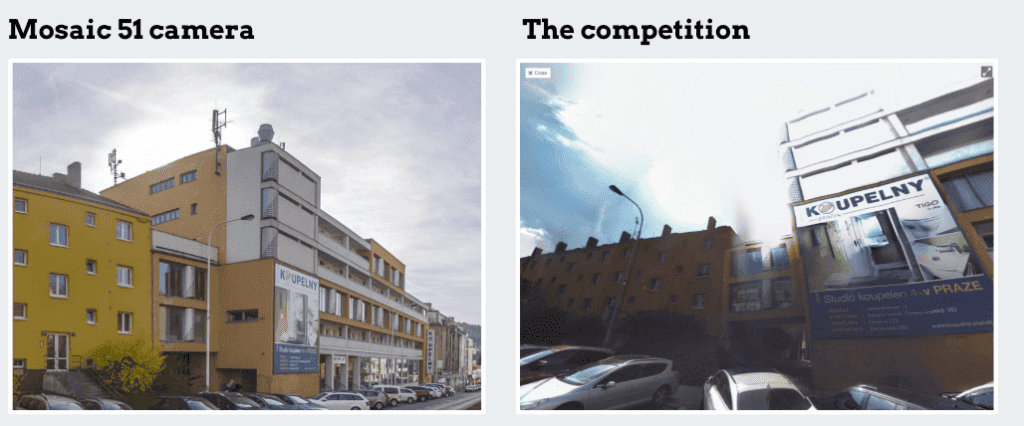
This is especially true in mobile mapping cameras, such as the Mosaic 51. This robust camera is built to function in any environment and produce expectational image results, no matter the light.
Disadvantages
As mentioned above, the distortion of the final images is, of course, quite an obvious disadvantage. This is especially true when filming visual effects, objects in motion, or scenes in which there are quick bursts of light, such as strobe lights or a lightning storm.
Other Uses of Rolling Shutter
Although rolling shutters are only found in digital, smartphone, and video cameras (mostly consumer goods), they have a variety of other uses. Rolling shutters can be found in
- electronics, such as circuit board alignment and inspection, as well as identification for code and text reading;
- Image analysis and documentation in microscopy;
- Pick & place applications in robotics; and
- Code reading and multi-code reading of products in pharmaceuticals.
What is a global shutter?
So you might have already guessed it – global shutters behave how most imagine a camera actually operates. All pixels within the frame of the lens are captured at the exact same moment. The sensor in the camera is exposed to light in one single moment of time, typically about 1/10th of a second (0.1 seconds).
This means that the sensor is capturing the whole image in one moment of time. No rolling or scanning. And as you can imagine, this means that the rolling shutter effect is eliminated. There is no blurring, no skewing, and no spatial or temporal aliasing.
Cameras with global shutter used to be, by nature, a charge-coupled device (CCD). However, as CCDs are partially obsolete, nearly all global shutter sensors on the market are now CMOS sensors. They are typically found in cameras for high-end broadcasting, astronomy, and even some mobile mapping cameras.
The Mosaic X and the Mosaic Viking are two examples of this. Both are highly operable at highway speeds and collect image data in high resolution. They are ideal for 3D modeling, reconstructions, and VFX.
What are the pros and cons of global shuttering?
Advantages
The consistency and accuracy of the images produced with CCD sensors and global shutter combine to give the global shutter an edge over the rolling shutter. Images produced with global shutters will accurately portray the object without any ‘jello effect’ or object segmentation.
Another advantage is that cameras may no longer require shutter blades. One of the most common failures among cameras is the shutter mechanism. If the camera has a global shutter, this risk is significantly reduced or eliminated altogether, as fewer moving parts means fewer chances of errors.
Disadvantages
One of the most significant disadvantages of global shutters is the price tag. Typically, cameras with global shutters are up to 10 times more expensive than their rolling shutter counterparts. For most amateur photographers, smartphone producers, and even some professionals, global shutters are not worth the price. Some manufacturers have even pulled global shutters out of their cameras when they found that the benefits didn’t warrant the additional costs.
In addition, global shutters are much more difficult to build. Without the ability to build the electronic components directly onto the sensor itself, production is much more complicated, which leads to higher prices.
Another disadvantage to global shutter is the poorer quality of the image. While the distortions might be gone, the overall image quality and dynamic range decrease. This can mean that the ‘blow-out’ will substantially increase.
The speed of the image readout for a global shutter is quite demanding, thus creating a much slower speed of only 1 to 40 MPS, while a rolling shutter boasts 100 to 400 MPS.
Other Uses of Global Shutter
Just as with rolling shutters, there are more applications for global shutters other than mere high-end cameras and video cameras for shooting movies and sporting events. Global shutters are in a wide array of technologies:
- Traffic management, allowing for the accurate capture of important information such as license plates
- Astronomy, “the observation of transient events or in order to limit the effect of atmospheric turbulences.”
- Metrology
- Infrastructure inspection and surveying
- Robotics inspection
- Agriculture
- Intelligent transportation systems
And now for the fun stuff:
The Rolling Shutter Effect in Action
Although unintentional, the rolling shutter effect creates some mind-blowing images, so enjoy and share.
This video clip of airplane propellers out an airplane window looks like the propellers are spinning the blades OFF the plane. They seem to be shedding off and falling to the ground.
This video does a great job of showing the stark difference between a CCD sensor (global shutter) and CMOS (rolling shutter) from within the cockpit. The front propeller, filmed with a CCD sensor, shows the propeller spinning as you would see with your naked eye. However, the other half shows the blades looking more like zebra stripes than straight, rigid blades.
The next clip is from within a guitar as the musician strums the strings. The guitar strings no longer seem to keep their straight lines but become radio waves with each finger or thumb pluck.
If you’re looking for some inspiration for some cool trick photos to impress your friends, check out these examples. And yes, you can try these at home:
- Spin a coin (or a fidget spinner)
- Throw a frisbee
- Take a picture of a reflection of someone blinking
Where we’re headed …
As previously mentioned, the debate about rolling shutter vs global shutter is very evenly divided. There are pros and cons to both, making it difficult for many without limitless sums of money to decide which way to go.
Global shutters give a much more accurate portrayal of the images and the scenery captured within the frame. While the price tag and the level of difficulty involved in developing a camera with global shutter capabilities can deter many from attempting it, there are camera, photography, and 360-mapping companies that see it in their future. The use of a global shutter on a more frequent basis will add new depth and clarity and completely change the game. Stay tuned for updates.

